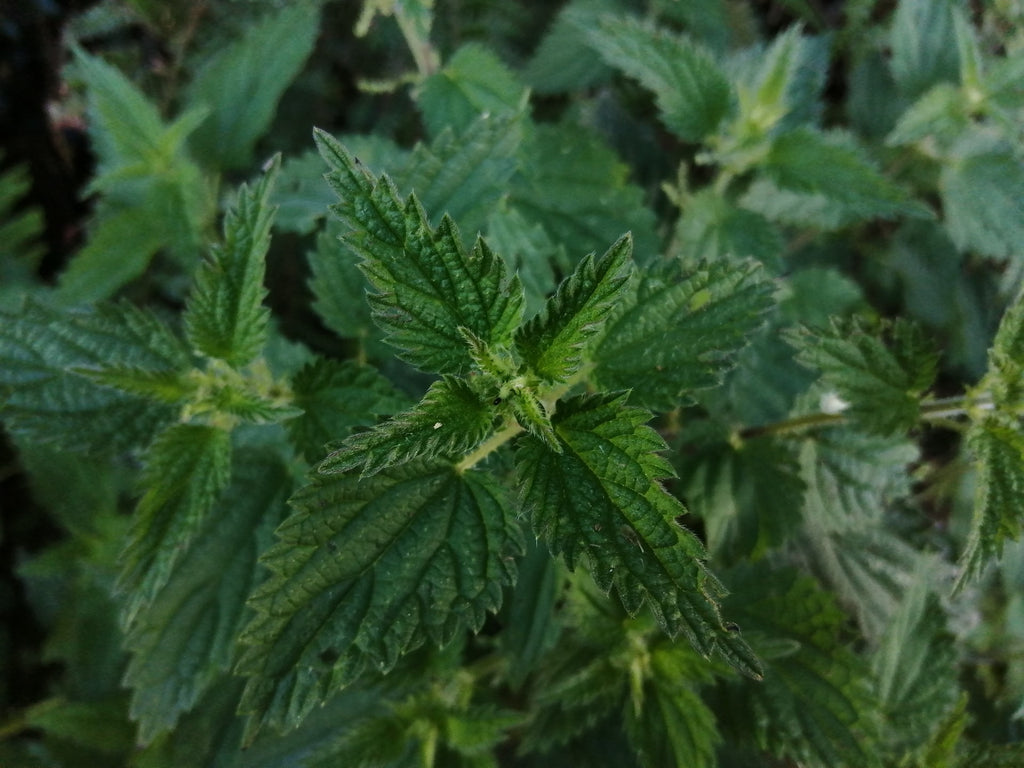Spring is here in Oregon and everything is waking up, ourselves included. What is in the garden? Poppies frilly and waking, tulips pushing up from their deep bed, and nettles bright and green. What lush life to come and a reminder to shake out the winter.
Remembering the day you met a plant is sometimes hard but others really stick with you. I met Nettles for the first time on a cliff overlooking the ocean up near Bellingham Bay in Washington, when I was about five years old. I remember the sharp, itchy pain, the crying and the vinegar that my mom poured on my hand to stop the sting. Little did I know at that age one day I would grow these wild plants intentionally and use them for medicine and food. Now… Nettles are a plant that always reminds me to take care of my body, whispering nourishment as I walk by.
Nettles, Urtica dioica, are an herbaceous perennial that grow wild in regions across the world and are often wildcrafted for use. I prefer to cultivate as many of the plants I use as possible, this helps me to observe and learn from them and lessens my impact on wild environments. Nettles are particularly easy to grow and lovely to have around when you want them. This is a dynamic plant which can grow up 6 feet tall, has “Green, slender, heart or elm shaped , serrated and rough textured leaves, 2-3” long” (1). They have tiny yellowish green flowers and the stems are covered in stinging hairs. The stinging hairs provide protection from predators. The rash produced by nettles usually goes away quickly and is a topical irritant. To avoid the sting, wear gloves to harvest. If you do not have gloves you can pinch the underside of the leaf, which does not have the stinging hairs. I like to use clippers and wear gloves to harvest the top few nodes of the plant. According to a study regarding the influence of harvest time on the chemical composition of Nettle, April is the ideal month to harvest leaves for high levels of iron and other trace minerals like phosphorus and zinc. In May the leaves become more acidic, produce more chlorophyll and have the most antioxidant properties (2).
References
1. Baumgardner DJ. Stinging nettle: the bad, the good, the unknown. J Patient Cent Res Rev.2016:3:48-53.
2. Paulauskiene, A.;Taravesciene, Z.; Laukagalis, V. Influence of Harvesting Time on the Chemical Composition of Wild Stinging Nettle( Urtica diocia L.). Plants.2021, 10,686. https://doi.org/10.3390/plants10040686
Nettles Growing Tips
The best method for growing Nettles I have found is to direct sow them in a prepared bed in early spring. Make rows in your bed and tamp the small nettle seeds into the surface of the soil as they need light to germinate. Nettles germinate in 10-14 days at optimum soil temperatures around 65 degrees. They can benefit from cold stratification so you can plant them quite early in the year or the previous fall. Once your nettles are established they will spread rhizomatically, the patch growing bushier and bushier each year. Nettles can be harvested for roots, stems, leaves and seeds depending on your intended use.
Nettles have so many uses, one of my first herb teachers taught us to make twine from the stalk fibers, I have seen the leaves used to dye yarn a lovely green, and there are countless ways to include the nourishing impact of nettles in your diet. Once freshly picked nettles wilt or dry they no longer can sting you. You can add them to soup, cook them up like spinach, add the leaves to your tea and make an incredible nettle pesto! Generally, I will eat some nettles fresh and then dry the rest for use throughout the year.

When I saw the nettles popping up this week I picked a handful and made some pesto. It has a much brighter taste than traditional basil pesto, a taste I can only describe as green! I add this to pasta dishes, use it as a spread or a base for a salad dressing. The following recipe is non traditional pesto made using a food processor instead of through crushing the ingredients together with a mortar.
Fresh Nettle Pesto Recipe
- 5 nettle sprigs
- 4 garlic cloves
- 2 tablespoons olive oil
- 2 tablespoons pine nuts ( pumpkin seed, walnut, pecan, almond can be used as a substitute)
- 1 tablespoon lemon juice
- Pinch salt and pepper to taste
- Blanch nettles in boiling water and then cold plunge into a bowl of ice water. This retains the delightful green color
- Blend nuts and garlic together with a food processor.
- Add the nettles and salt and pulse to roughly combine into a paste.
- Add the lemon juice and slowly pour in the olive oil so that it combines into your preferred texture spread.
- Add more salt if needed and a little pepper to taste
≈ by Taryn Hunter


Comments (0)